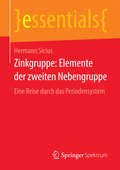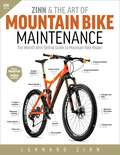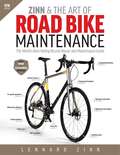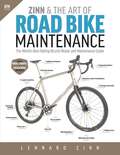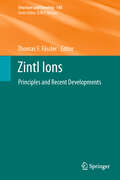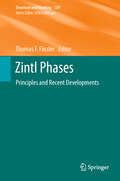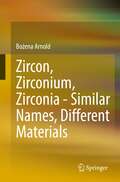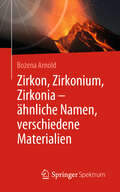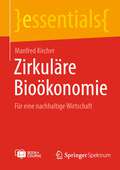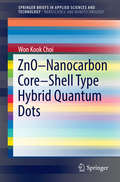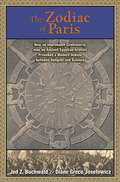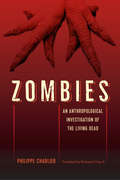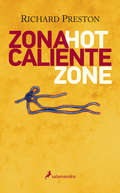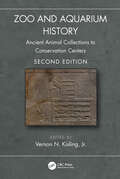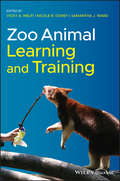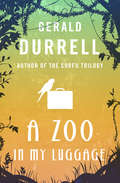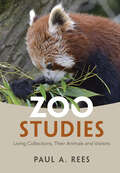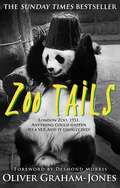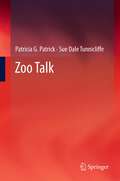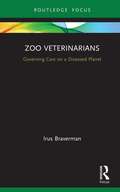- Table View
- List View
Zinc Signals in Cellular Functions and Disorders
by Toshiyuki Fukada Taiho KambeThis book describes the crucial role of "zinc signals" in biological processes on a molecular and physiological basis, discussing future directions and questions underlying this unique phenomenon. To accomplish this, a group of worldwide leaders in the field, who have made outstanding contributions, overview zinc signals from a professional standpoint. Zinc plays an indispensable role in various cellular processes. It regulates a great number of protein functions including transcription factors, enzymes, adapters, and growth factors as a structural or catalytic factor or both. Recently, another function of zinc has received extensive interest and attention because of its potential importance as a signaling mediator. Zinc plays a dynamic role as an intracellular and extracellular signaling factor and thus regulates cellular signaling pathways, which enables communication between cells, conversion of extracellular stimuli to intracellular signals, and control of various intracellular events. These functions of zinc have become recognized as "zinc signals," which play critical roles in physiology, and therefore their imbalance can cause a variety of problems with regard to human health. Because the notion of zinc signals is quite new and no integrative review books focusing on them have yet been published, we believe this book will provide very timely information on the subject and thus should be of importance and interest to a wide range of readers.
Zinkgruppe: Eine Reise durch das Periodensystem (essentials)
by Hermann SiciusHermann Sicius stellt ausf#65533;hrlich die Elemente der zweiten Nebengruppe vor (Zink, Cadmium, Quecksilber, Copernicium), deren physikalische und chemische Eigenschaften relativ #65533;hnlich sind. Auswirkungen der Lanthanoidenkontraktion erkennt man hier kaum noch. Cadmium steht in seinen Eigenschaften etwa zwischen dem Zink und dem Quecksilber. Zink und Cadmium haben negative Normalpotentiale, wogegen Quecksilber ein Halbedelmetall ist. Die Elemente dieser Gruppe geben meist ein oder zwei #65533;u#65533;ere Valenzelektronen ab, um eine stabile Elektronenkonfiguration zu erreichen. F#65533;r das h#65533;chste Element dieser Nebengruppe, das Copernicium, konnten bisher kaum chemische Untersuchungen durchgef#65533;hrt werden. Es ist zu erwarten, dass es sich chemisch #65533;hnlich wie Quecksilber verh#65533;lt. Zink als Element kennt man seit dem 17. Jahrhundert, Cadmium seit 1817, wogegen Quecksilber schon in der Antike bekannt war. Die erstmalige Darstellung von Atomen des Coperniciums gelang 1996.
Zinn & the Art of Mountain Bike Maintenance: The World's Best-Selling Guide to Mountain Bike Repair
by Lennard ZinnZinn & the Art of Mountain Bike Maintenance is the world&’s best-selling guide to the maintenance and repair of mountain bikes, hybrids, and fat bikes.From basic repairs like how to fix a flat to advanced overhauls of drivetrains and brakes, Lennard Zinn&’s clearly illustrated guide makes every bike repair and maintenance job easy for everyone. Lennard Zinn is the world&’s leading expert on bike maintenance and repair. His friendly, step-by-step guide explains the tools and parts you&’ll need and how to know you&’ve done the job right. The book&’s interior is easy to read, even in a dimly-lit garage or workshop. Hundreds of hand-drawn illustrations and exploded-parts diagrams show just the right level of detail to lead you through every mountain bike repair task. This smartly organized guide shows how to repair new and old mountain bikes from top to bottom. In over 500 pages and more than 750 illustrations, Zinn&’s guide includes simple instructions for hundreds of mountain bike maintenance and repair jobs: Basics: How to fix a flat tire, lube a bicycle chain, adjust the brakes Emergency repairs: How to fix a broken chain, tighten loose spokes, repair a bent derailleur Easy shifting: How to adjust shifters, derailleurs, and cables for clean and smooth shifting Wheels: How to true a wheel, install a new tire, change a cassette, replace broken spokes, build your own wheels Overhauls: How to service and replace pedals, chains and chainrings, saddles, handlebars, stems, headsets, forks, bottom brackets New tech: How to maintain 1x-speed systems, electronic and wireless shifters Troubleshooting: How to figure out what&’s wrong with any bike and fix it Zinn & the Art of Mountain Bike Maintenance makes bicycle repair and maintenance easy, quick, affordable, and fun. With Zinn at your side, you&’ll know how to keep your bicycle running smoothly for years. New in the 6th Edition: A chapter on electronic shifting covers maintenance, service, repair, and troubleshooting of all Shimano electronic shifting groups. Also included: How to program your electronic shifting system for personalized shifting as well as real-time display and shift recording on a head unit. A chapter on disc brakes covers maintenance, service, and repair of all hydraulic and mechanical systems. Includes integrated systems and their bleeding requirements. New guides on how disc brake mounting adapters work and how to install them. Complete info on the new 11-speed and SRAM 12-speed drivetrains. Info on all the newest bottom brackets including 1x11 and 1x12 systems. New guidelines on wheel size selection for your frame size, suspension settings, and travel. New procedures for mounting and sealing tubeless tire systems. New usage guidelines for flat-prevention sealants. Updated guides on replacing press-in bottom brackets with thread-in bottom brackets. New wheel lacing guidelines for building disc-brake compatible wheels. Updated and expanded guides on how to tune, rebuild, and maintain suspension forks and rear shocks. Includes tuning guides for preload, compression, rebound, and sag. Updated and revised troubleshooting tables, torque tables, and gearing charts for 26&”, 27.5&”, and 29&” bikes. Also covered in the 6th edition: All derailleur shifting systems; all bottom bracket systems; all brake systems; all headset, stem, handlebar and fork systems; wheelbuilding for all bikes; updated and expanded torque tables; complete indexes of all illustrations and topics covered. Whether you&’re riding a classic Stumpjumper or a carbon-fiber race machine, Zinn has got you covered!
Zinn & the Art of Road Bike Maintenance: The World's Best-Selling Bicycle Repair and Maintenance Guide
by Lennard ZinnZinn & the Art of Road Bike Maintenance is the world&’s best-selling guide to bicycle repair and maintenance.From basic repairs like how to fix a flat tire to advanced overhauls of drivetrains and brakes, Lennard Zinn&’s clearly illustrated guide makes every bicycle repair and maintenance job easy for everyone. Lennard Zinn is the world&’s leading expert on bike maintenance and repair. His friendly step-by-step guide explains the tools you&’ll need and how to know you&’ve done the job right. The book&’s interior is easy to read, even in a dimly-lit garage or workshop. Hundreds of hand-drawn illustrations and exploded parts diagrams show just the right level of detail to lead you through every bicycle repair task. This smartly organized guide shows how to repair new and old bicycles from top to bottom. In over 500 pages, Zinn&’s guide includes simple instructions for hundreds of bike maintenance and repair jobs: Basics: How to fix a flat tire, lube a bicycle chain, adjust the brakes Emergency repairs: How to fix a broken chain, tighten loose spokes, repair a bent derailleur Easy shifting: How to adjust shifters, derailleurs, and cables for clean and smooth shifting Wheels: How to true a wheel, install a new tire, change a cassette, replace broken spokes, build your own wheels Overhauls: How to service and replace pedals, chains and chainrings, saddles, handlebars, stems, headsets, forks, bottom brackets New tech: How to maintain 11-speed systems, electronic and wireless shifters, disc brakes Cyclocross: How to set up a &’cross bike for racing, select the right components, and make quick repairs Troubleshooting: How to figure out what&’s wrong with any bike and fix it Zinn & the Art of Road Bike Maintenance makes bicycle repair and maintenance easy, quick, affordable, and fun. With Zinn at your side, you&’ll know how to keep your bicycling running smoothly for years. What&’s New in Zinn & the Art of Road Bike Maintenance, 5th Ed.: More than 700 comprehensive illustrations and exploded views. New chapter on electronic shifting covers maintenance, service, repair, and troubleshooting of all Shimano, SRAM, and Campagnolo electronic shifting groups. New chapter on disc brakes covers maintenance, service, and repair of all hydraulic and mechanical systems. New tech covered in depth: through-axle forks, SRAM eTap wireless shifting, second generation Shimano and Campagnolo electronic shifting, direct-mount sidepull brakes, SRAM X-Sync 1x11 cyclocross systems, tubular tire gluing tapes. New troubleshooting charts New master guide to press-fit bottom brackets Also covered in the 5th edition: All derailleur shifting systems (5-speed through 11-speed); all bottom bracket systems (cone-and-cup through press-fit); all brake systems (including caliper, V-brake, cantilever, and disc); all headset, stem, handlebar and fork systems; wheelbuilding for all bikes including cyclocross and disc-brake wheels; special sections on cyclocross throughout including troubleshooting, maintenance, service, repair, and equipment selection; updated and expanded torque tables; complete illustration index and complete subject index.
Zinn & the Art of Road Bike Maintenance: The World's Best-Selling Bicycle Repair and Maintenance Guide, 6th Edition
by Lennard ZinnJoin the millions of cyclists who swear by the name Zinn. Now in its sixth edition, Zinn & the Art of Road Bike Maintenance is the world&’s best-selling guide to bicycle repair and maintenance. Lennard Zinn is the world&’s leading expert on bike maintenance and repair. From basic repairs like how to fix a flat tire to advanced overhauls of drivetrains and brakes, his illustrated, step-by-step guide explains the tools you&’ll need and how to know you&’ve done the job right. This book's interior is easy to read, even in a dimly lit garage or workshop. Hundreds of hand-drawn illustrations and exploded parts diagrams show just the right level of detail to lead you through every bicycle repair task. In over 450 pages, Zinn&’s guide includes simple instructions for hundreds of bike maintenance and repair jobs, including: Basics: How to fix a flat tire, lube a bicycle chain, adjust the brakes Emergency repairs: How to fix a broken chain, tighten loose spokes, repair a bent derailleur Easy shifting: How to adjust shifters, derailleurs, and cables for clean and smooth shifting Wheels: How to true a wheel, install a new tire, change a cassette, replace broken spokes, build your own wheels Overhauls: How to service and replace pedals, chains and chainrings, saddles, handlebars, stems, headsets, forks, bottom brackets New tech: How to maintain 11-speed systems, electronic and wireless shifters, disc brakes Cyclocross: How to set up a &’cross bike for racing, select the right components, and make quick repairs Troubleshooting: How to figure out what&’s wrong with any bike and fix it This sixth edition of Zinn & the Art of Road Bike Maintenance also includes more than 50 new illustrations as well as completely new information on routing internal wires, cables, hoses, and housing; how to pack bikes for shipping and air travel; repair on the road tips for tubeless tires; how to chain wax, and so much more. This guide makes bicycle repair and maintenance easy, quick, affordable, and fun. With Zinn at your side, you&’ll know how to keep your bicycling running smoothly for years.
Zintl Ions
by Thomas F. FässlerR. Bruce King: Structure and Bonding in Zintl Ions and Related Main Group Element Clusters Stefanie Gärtner, Nikolaus Korber: Polyanions of Group 14 and Group 15 Elements in Alkali and Alkaline Earth Metal Solid State Compounds and Solvate Structures Bryan Eichhorn, Sanem Kocak: Dynamic Properties of the Group 14 Zintl Ions and Their Derivatives Thomas F. Fässler: Relationships between soluble Zintl anions, ligand-stabilized cage compounds, and intermetalloid clusters of tetrel (Si - Pb) and pentel (P - Bi) elements Gerasimos S. Armatas, Mercouri Kanatzidis: Germanium-Based Porous Semiconductors from Molecular Zintl Anions
Zintl Phases
by Thomas F. FässlerGordon J. Miller, Michael W. Schmidt, Fei Wang, Tae-Soo You: Quantitative Advances in the Zintl-Klemm Formalism Jürgen Evers: High Pressure Investigations on AIBIII Zintl Compounds (AI = Li to Cs; BIII = Al to Tl) up to 30 GPa Andrei Shevelkov, Kirill Kovnir: Zintl Clathrates Ulrich Häussermann, Verina F. Kranak, Kati Puhakainen: Hydrogenous Zintl Phases: Interstitial versus Polyanionic Hydrides
Zircon, Zirconium, Zirconia - Similar Names, Different Materials
by Bożena ArnoldIn this book you will find a lot of exciting and often astonishing information about these extraordinary and diverse materials. The presentation is essentially structured chronologically and follows the history of the discovery of these materials. Their properties and areas of application are described. The book is a mixture of specialist and non-fiction: understandable for experts and laypeople.This book is a translation of the original German 1st edition Zirkon, Zirkonium, Zirkonia - ähnliche Namen, verschiedene Materialien by Bożena Arnold, published by Springer-Verlag GmbH Germany, part of Springer Nature in 2019. The translation was done with the help of artificial intelligence (machine translation by the service DeepL.com). A subsequent human revision was done primarily in terms of content, so that the book will read stylistically differently from a conventional translation. Springer Nature works continuously to further the development of tools for the production of books and on the related technologies to support the authors.
Zirkon, Zirkonium, Zirkonia - ähnliche Namen, verschiedene Materialien
by Bożena ArnoldIm vorliegenden Buch finden Sie viele spannende und oft erstaunliche Informationen über diese außergewöhnlichen und vielfältigen Materialien. Die Darstellung ist im Wesentlichen chronologisch aufgebaut und folgt der Geschichte der Entdeckung dieser Materialien. Dabei werden ihre Eigenschaften und Anwendungsbereiche beschrieben. Das Buch stellt eine Mischung aus Fach- und Sachbuch dar: verständlich für Fachleute und Laien.
Zirkuläre Bioökonomie: Für eine nachhaltige Wirtschaft (essentials)
by Manfred KircherFür Lebensmittel, Kleidung, Medizin, Papier, Chemieprodukte sind und bleiben wir auf kohlenstoffhaltige Rohstoffe angewiesen. Um fossile Rohstoffe abzulösen, muss die Industrie auf nachhaltige Kohlenstoffquellen umsteigen. Infrage kommt Biomasse aus der Land- und Forstwirtschaft, die aber selbst begrenzt ist. Das Konzept der zirkulären Bioökonomie sieht deshalb die verstärkte Nutzung von Reststoffen, Bio-Abfällen und CO2 vor. Um die Umstellung der Wirtschaft bis zum Jahr 2045 zu erreichen, müssen Infrastruktur und Rahmenbedingungen zügig angepasst werden.Den kostenlosen Zugang zum Online-Kurs finden Sie direkt im Buch.
ZnO-Nanocarbon Core-Shell Type Hybrid Quantum Dots
by Won Kook ChoiThis book offers a comprehensive overview of ZnO-nano carbon core shell hybrid issues. There is significant interest in metal oxide/nanocarbon hybrid functional materials in the field of energy conversion and storage as electrode materials for supercapacitors, Li ion secondary battery, electrocatalysts for water splitting, and optoelectronic devices such as light emitting diodes and solar photovoltaic cells. Despite efforts to manipulate more uniform metal oxide-nanocarbon nanocomposite structures, they have shown poor performance because they are randomly scattered and non-uniformly attached to the nanocarbon surface. For higher and more effective performance of the hybrid structure, 3D conformal coating on metal oxides are highly desirable. In the first part of the book, the physical and chemical properties of ZnO and nanocarbons and the state-of-the-art in related research are briefly summarized. In the next part, the 3D conformal coating synthetic processes of ZnO templated nanocarbon hybrid materials such as ZnO-graphene,-C60, single-walled (SWCNT) are introduced with the aid of schematic illustrations. Analysis of their chemical bonding and structure are also presented. In the final section, several applications are presented: UV photovoltaic cells and photoelectrochemical anodes for water splitting using ZnO-C60 and ZnO-graphene, white-light-emitting diodes based on ZnO-graphene quantum dots(GQDs), inverted solar cells using ligand-modified ZnO-graphene QDs, and P(VDF-TrFE) copolymer with mixed with nano-ring SWCNT. The book describes how strong anchoring bonds between a ZnO core and carbon nanomaterial shell will ultimately prevail over the main drawbacks of ZnO with high charge recombination and poor electrochemical stability in liquid solutions. Due to the moderate energy states and excellent electric properties of the nanocarbons, ultrafast charge carrier transport from the ZnO core to the nanocarbon shell is guaranteed with the use of the photoluminescence (PL) lifetime measurement. Given the growing interest and significance of future research in optoelectronic and electrochemical devices applications, the contents are very timely. This book is targeted towards researchers looking for highly efficient metal oxide-nanocarbon hybrid functional materials in the fields of nano-optoelectronics, photoelectrochemistry, energy storage and conversion.
ZnO Nanocrystals and Allied Materials
by M S Ramachandra Rao Tatsuo OkadaZnO has been the central theme of research in the past decade due to its various applications in band gap engineering, and textile and biomedical industries. In nanostructured form, it offers ample opportunities to realize tunable optical and optoelectronic properties and it was also termed as a potential material to realize room temperature ferromagnetism. This book presents 17 high-quality contributory chapters on ZnO related systems written by experts in this field. These chapters will help researchers to understand and explore the varied physical properties to envisage device applications of ZnO in thin film, heterostructure and nanostructure forms.
The Zodiac of Paris: How an Improbable Controversy over an Ancient Egyptian Artifact Provoked a Modern Debate between Religion and Science
by Jed Z. Buchwald Diane Greco JosefowiczThe clash of faith and science in Napoleonic FranceThe Dendera zodiac—an ancient bas-relief temple ceiling adorned with mysterious symbols of the stars and planets—was first discovered by the French during Napoleon's campaign in Egypt, and quickly provoked a controversy between scientists and theologians. Brought to Paris in 1821 and ultimately installed in the Louvre, where it can still be seen today, the zodiac appeared to depict the nighttime sky from a time predating the Biblical creation, and therefore cast doubt on religious truth. The Zodiac of Paris tells the story of this incredible archeological find and its unlikely role in the fierce disputes over science and faith in Napoleonic and Restoration France.The book unfolds against the turbulence of the French Revolution, Napoleon's breathtaking rise and fall, and the restoration of the Bourbons to the throne. Drawing on newspapers, journals, diaries, pamphlets, and other documentary evidence, Jed Buchwald and Diane Greco Josefowicz show how scientists and intellectuals seized upon the zodiac to discredit Christianity, and how this drew furious responses from conservatives and sparked debates about the merits of scientific calculation as a source of knowledge about the past. The ideological battles would rage until the thoroughly antireligious Jean-François Champollion unlocked the secrets of Egyptian hieroglyphs—and of the zodiac itself. Champollion would prove the religious reactionaries right, but for all the wrong reasons.The Zodiac of Paris brings Napoleonic and Restoration France vividly to life, revealing the lengths to which scientists, intellectuals, theologians, and conservatives went to use the ancient past for modern purposes.
Zombies: An Anthropological Investigation of the Living Dead
by Philippe Charlier“A compelling account of the zombi as an anthropological reality and evocative symbol of a state of dispossession, desperation, and death.”—Roger Luckhurst, author of Zombies: A Cultural History “An adventurer’s anthropological quest offering a novel description of the contemporary zombie.”—Sarah J. Lauro, author of The Transatlantic Zombie: Slavery, Rebellion, and Living Death “Displays an empathy for the cultural reality of the zombie in Haiti that delivers important insight on the island nation’s people and their lived realities.”—Christopher M. Moreman, coeditor of Race, Oppression and the Zombie: Essays on Cross-Cultural Appropriations of the Caribbean Tradition Forensic pathologist Philippe Charlier—dubbed the “Indiana Jones of the graveyards”—travels to Haiti where rumors claim that some who die may return to life as zombies. Charlier investigates these far-fetched stories and finds that, in Haiti, the dead are a part of daily life. Families, fearing that loved ones may return from the grave, urge pallbearers to take rambling routes to prevent the recently departed from finding their way home from cemeteries. Corpses are sometimes killed a second time…just to be safe. And a person might spend their life preparing their funeral and grave to ensure they will not become a wandering soul after death. But are the stories true? Charlier’s investigations lead him to Vodou leader Max Beauvoir and other priests, who reveal how bodies can be reanimated. In some cases, sorcerers lure the dead from their graves and give them a potion concocted from Devil’s Snare, a plant more commonly known as Jimsonweed. Sometimes secret societies use poudre zombi—“zombie powder”—spiked with the tetrodotoxin found in blowfish. Charlier eagerly collects evidence, examining Vodou dolls by X-ray, making sacrifices at rituals, and visiting cemeteries under the cloak of night. Zombies follows Charlier’s journey to understand the fascinating and frightening world of Haiti’s living dead, inviting readers to believe the unbelievable.
Zona caliente
by Richard PrestonLa historia del brote de Ébola más mortífero en la historia: un relato apasionante de los médicos y científicos que lucharon, y luchan, por protegernos. Zona caliente: área del laboratorio denominada así por los científicos que investigan los virus más letales como el ébola. Sellada herméticamente, sus accesos están rigurosamente controlados y los operarios visten trajes especiales sometidos a duchas de desinfección antes de abandonar el recinto. Parte de los hechos narrados en este libro transcurren en una «zona caliente» gestionada por el Ejército de Estados Unidos en Maryland. Zona caliente fue escrito y publicado en 1994 para explicar los orígenes y la evolución del virus ébola y advertir del peligro de su propagación en el futuro. Su autor, Richard Preston, catedrático de la Universidad de Princeton y un destacado especialista en abordar temas científicos con un alto nivel de rigor y conocimiento de la materia -ha sido galardonado con el Premio del Instituto de Física de Estados Unidos y Zona caliente es lectura recomendada en los institutos de Norteamérica-, fue el primero en dar a conocer al gran público la amenaza del ébola, un virus potencialmente mil veces más letal que el VIH del sida y que, hasta el día de hoy, no ha sido controlado en su totalidad. La narración de esta historia, que se lee como una novela, se basa en hechos reales documentados con precisión y contrastados hasta el límite de lo posible. El resultado es un relato apasionante y esclarecedor, una fuente rica en datos fidedignos sobre todos los aspectos involucrados en este desafío de la naturaleza. Así, los lectores podrán formarse una opinión razonada por encima de todo el torrente de informaciones fragmentadas que propician en la opinión pública una sensación de desconcierto y temor.
Zoo and Aquarium History: Ancient Animal Collections to Conservation Centers
by Vernon N. Kisling Jr.Wild animals have been housed in zoos and aquariums for 5,000 years, fascinating people living in virtually every society. Today, these institutions are at a new milestone in their history. This second edition of Zoo and Aquarium History takes the reader on a journey through the transition of private collections to menageries, to zoos, then zoological gardens, and more recently conservation centers and sanctuaries. Under the direction of Vernon N. Kisling, an expert in zoo history, an international team of authors has thoroughly updated the only comprehensive, global history of animal collections, menageries, zoos, and aquariums. The resulting book documents the continuum of efforts in maintaining wild animal collections from ancient civilizations through today, explaining how modern zoos have developed their mission statements around the core aims of conservation, education, research and recreation. This new edition pulls together regional information, including new chapters on zoological gardens of Canada, Latin America, China, Israel, the Middle East, and New Zealand, along with the cultural aspects of each region to provide a foundation upon which further research can be based. It presents a chronological listing of the world's zoos and aquariums and features many never-before published photographs. Sidebars present supplementary information on pertinent personalities, events, and wildlife conservation issues. The original Appendix has been expanded to include over 1,200 zoos and aquariums, providing an invaluable resource. This is an extensive, chronological introduction to the subject, highlighting the published and archival resources for those who want to know more.
Zoo Animal Learning and Training
by Vicky A. Melfi Nicole R. Dorey Samantha J. WardComprehensively explains animal learning theories and current best practices in animal training within zoos This accessible, up-to-date book on animal training in a zoo/aquaria context provides a unified approach to zoo animal learning, bringing together the art and science of animal training. Written by experts in academia and working zoos, it incorporates the latest information from the scientific community along with current best practice, demystifying the complexities of training zoo animals. In doing so, it teaches readers how to effectively train animals and to fully understand the consequences of their actions. Zoo Animal Learning and Training starts with an overview of animal learning theory. It describes the main categories of animal learning styles; considers the diverse natural history of zoo animals; reviews the research undertaken which demonstrates ultimate benefits of learning; and highlights the advantages and disadvantages of the different approaches. It also shows how the direct application of learning theory can be integrated into zoo animal management; discusses how other factors might affect development; and investigates situations and activities from which animals learn. It also explores the theoretical basis that determines whether enrichments are successful. Provides an easily accessibly, jargon-free introduction to the subject Explores different training styles, providing theoretical background to animal learning theory as well as considerations for practical training programme – including how to set them up, manage people and animals within them and their consequences Includes effective skills and ‘rules of thumb’ from professional animal trainers Offers commentary on the ethical and welfare implications of training in zoos Features contributions from global experts in academia and the zoo profession Uniquely features both academic and professional perspectives Zoo Animal Learning and Training is an important book for students, academics and professionals. Suited to senior undergraduate students in zoo biology, veterinary science, and psychology, and for post-graduate students in animal management, behaviour and conservation, as well as zoo biology. It is also beneficial to those working professionally in zoos and aquaria at different levels.
Zoo Animal Welfare
by Terry Maple Bonnie M PerdueZoo Animal Welfare thoroughly reviews the scientific literature on the welfare of zoo and aquarium animals. Maple and Perdue draw from the senior author's 24 years of experience as a zoo executive and international leader in the field of zoo biology. The authors' academic training in the interdisciplinary field of psychobiology provides a unique perspective for evaluating the ethics, practices, and standards of modern zoos and aquariums. The book offers a blueprint for the implementation of welfare measures and an objective rationale for their widespread use. Recognizing the great potential of zoos, the authors have written an inspirational book to guide the strategic vision of superior, welfare-oriented institutions. The authors speak directly to caretakers working on the front lines of zoo management, and to the decision-makers responsible for elevating the priority of animal welfare in their respective zoo. In great detail, Maple and Perdue demonstrate how zoos and aquariums can be designed to achieve optimal standards of welfare and wellness.
A Zoo in My Luggage: A Zoo In My Luggage, The Whispering Land, And Menagerie Manor (The Zoo Memoirs #1)
by Gerald DurrellWhat happens when the charming, animal-obsessed boy of the classic memoirs 'My Family and Other Animals' and 'Birds, Beasts and Other Relatives' grows up? He founds a zoo, of course.
Zoo in the Sky: A Book of Animal Constellations
by Jacqueline MittonLittle Bear and the Great Bear in the Northern Sky; the scaly dragon winding his long tail; the Great Dog chasing the Hare in the Southern Sky; all are beautifully rendered in Christina Balit's vibrant art, studded with shiny stars, which perfectly illustrates Jacqueline Mitton's rich text.
Zoo Studies: Living Collections, Their Animals and Visitors
by Paul A. ReesZoos and aquariums are culturally and historically important places where families enjoy their leisure time and scientists study exotic animals. Many contain buildings of great architectural merit. Some people consider zoos little more than animal prisons, while others believe they play an important role in conservation and education. Zoos have been the subject of a vast number of academic studies, whose results are scattered throughout the literature. This interdisciplinary volume brings together research on animal behaviour, visitor studies, zoo history, human-animal relationships, veterinary medicine, welfare, education, enclosure design, reproduction, legislation, and zoo management conducted at around 200 institutions located throughout the world. The book is neither 'pro-' nor 'anti-' zoo and attempts to strike a balance between praising zoos for the good work they have done in the conservation of some species, while recognising that they face many challenges in making themselves relevant in the modern world.
Zoo Tails
by Oliver Graham JonesOne puff adder, one antelope, one crocodile – This was the list of sick animals presented to Oliver Graham-Jones on his first day as a new vet at London Zoo in 1951. And his time at the zoo didn’t get any less strange or entertaining…There’s the time he anaesthetized, and was then chased by, a gorilla; had to capture an angry polar bear in thick fog; performed a colostomy on a python; and fitted a raven in the Tower of London with a wooden leg. And if an animal escaped (more frequently than you might think) or required urgent medical attention, he was always on hand, ready for any eventuality. With his self-deprecating humour, Oliver frequently described himself as quaking with fear, but he was also skilful, brave and, most of all, incredibly caring and kind to his animal patients.
Zoo Talk
by Sue Dale Tunnicliffe Patricia G. PatrickFounded on the premise that zoos are 'bilingual'--that the zoo, in the shape of its staff and exhibits, and its visitors speak distinct languages--this enlightening analysis of the informal learning that occurs in zoos examines the 'speech' of exhibits and staff as well as the discourse of visitors beginning in the earliest years. Using real-life conversations among visitors as a basis for discussion, the authors interrogate children's responses to the exhibits and by doing so develop an 'informal learning model' and a 'zoo knowledge model' that prompts suggestions for activities that classroom educators can use before, during, and after a zoo visit. Their analysis of the 'visitor voice' informs creative suggestions for how to enhance the educational experiences of young patrons. By assessing visitors' entry knowledge and their interpretations of the exhibits, the authors establish a baseline for zoos that helps them to refine their communication with visitors, for example in expanding knowledge of issues concerning biodiversity and biological conservation. The book includes practical advice for zoo and classroom educators about positive ways to prepare for zoo visits, engaging activities during visits, and follow-up work that maximizes the pedagogical benefits. It also reflects on the interplay between the developing role of zoos as facilitators of learning, and the ways in which zoos help visitors assimilate the knowledge on offer. In addition to being essential reading for educators in zoos and in the classroom, this volume is full of insights with much broader contextual relevance for getting the most out of museum visits and field trips in general.
Zoo Veterinarians: Governing Care on a Diseased Planet (Law, Science and Society)
by Irus BravermanDespite their centrality to the operation of contemporary accredited zoo and aquarium institutions, the work of zoo veterinarians has rarely, if ever, been the focus of a critical analysis in the social science and humanities. Drawing on in-depth interviews and observations of zoo and aquarium veterinarians in Europe and North America, this book highlights the recent transformation that has occurred in the zoo veterinarian profession during a time of ecological crisis, and what these changes can teach us about our rapidly changing planet. Zoo vets, Braverman instructs us with a wink, have "gone wild." Originally an individual welfare-centered profession, these experts are increasingly concerned with the sustainability of wild animal populations and with ecological health. In this sense, the story of zoo vets "going wild"—in their subjects of care, their motivations, and their ethical standards, as well as in their professional practices and scientific techniques—is also a story about zoo animals gone wild, wild animals encroaching the zoo, and, more generally, a wild world that is becoming "zoo-ified." Such transformations have challenged existing norms of veterinary practice. Exploring the regulatory landscape that governs the work of zoo and aquarium veterinarians, Braverman traverses the gap between the hard and soft sciences and between humans and nonhumans. At the intersection of animal studies, socio-legal studies, and Science and Technology Studies, this book will appeal not only to those interested in zoos and in animal welfare, but also to scholars in the posthumanities.
Zooarchaeology
by Elizabeth J. Reitz Elizabeth S. WingThis book includes new sections on enamel ultra structure and incremental analysis, stable isotopes and trace elements, ancient genetics and enzymes, environmental reconstruction, people as agents of environmental change etc.

